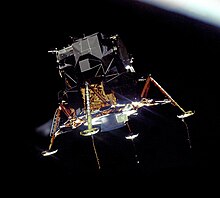Lunar Module Eagle: Difference between revisions
Randy Kryn (talk | contribs) create and redirect to 'Apollo 11' (name of ship) Tag: New redirect |
Tag: Removed redirect |
||
| Line 1: | Line 1: | ||
[[File:Apollo 11 Lunar Module Eagle in landing configuration in lunar orbit from the Command and Service Module Columbia.jpg|thumb|right|''Eagle'' in [[lunar orbit]] photographed from ''[[Command module Columbia|Columbia]]'']] |
|||
#REDIRECT [[Apollo 11]] |
|||
{{Apollo11series}} |
|||
'''Lunar Module ''Eagle''''' ('''LM-5''') is the spacecraft that served as the [[lunar module]] during [[Apollo 11]], which was the first mission to [[Moon landing|land humans]] on the [[Moon]]. It was named after the motif which was featured prominently on [[:File:Apollo 11 insignia.png|the mission insignia]]. |
|||
There were several differences between ''Eagle'' and [[Apollo 10]]'s LM-4 ''Snoopy''; ''Eagle'' had a VHF radio antenna to facilitate communication with the astronauts during their EVA on the lunar surface; a lighter ascent engine; more thermal protection on the landing gear; and a package of scientific experiments known as the [[Early Apollo Scientific Experiments Package]] (EASEP). The only change in the configuration of the command module was the removal of some insulation from the forward hatch.{{sfn|Benson|Faherty|1978|p=472}}<ref>{{cite web |url=https://airandspace.si.edu/exhibitions/apollo-to-the-moon/online/science/scientific-experiments.cfm |title=Scientific Experiments |website=Smithsonian Air and Space Museum|access-date=September 22, 2018}}</ref> |
|||
The descent stage of the LM ''Eagle'' remains on the Moon. In 2009, the [[Lunar Reconnaissance Orbiter]] (LRO) imaged the various Apollo landing sites on the surface of the Moon, for the first time with sufficient resolution to see the descent stages of the lunar modules, scientific instruments, and foot trails made by the astronauts.<ref>{{cite web |url=https://www.nasa.gov/mission_pages/LRO/multimedia/lroimages/apollosites.html |title=LRO Sees Apollo Landing Sites |publisher=NASA |access-date=September 25, 2018|date=July 17, 2009}}</ref> The remains of the ascent stage lie at an unknown location on the lunar surface, after being abandoned and impacting the Moon. The location is uncertain because ''Eagle'' ascent stage was not tracked after it was jettisoned, and the lunar gravity field is sufficiently non-uniform to make the orbit of the spacecraft unpredictable after a short time.<ref>{{cite web |url=https://airandspace.si.edu/explore-and-learn/topics/apollo/apollo-program/spacecraft/location/lm.cfm?dom=pscau |title=Location of Apollo Lunar Modules |website=Smithsonian Air and Space Museum|access-date=September 24, 2018}}</ref> |
|||
== References == |
|||
{{reflist}} |
|||
{{space-stub}} |
|||
{{Apollo program}} |
|||
Revision as of 16:38, 25 July 2020

 |
| Part of a series on |
| Apollo 11 |
|---|
|
Lunar Module Eagle (LM-5) is the spacecraft that served as the lunar module during Apollo 11, which was the first mission to land humans on the Moon. It was named after the motif which was featured prominently on the mission insignia.
There were several differences between Eagle and Apollo 10's LM-4 Snoopy; Eagle had a VHF radio antenna to facilitate communication with the astronauts during their EVA on the lunar surface; a lighter ascent engine; more thermal protection on the landing gear; and a package of scientific experiments known as the Early Apollo Scientific Experiments Package (EASEP). The only change in the configuration of the command module was the removal of some insulation from the forward hatch.[1][2]
The descent stage of the LM Eagle remains on the Moon. In 2009, the Lunar Reconnaissance Orbiter (LRO) imaged the various Apollo landing sites on the surface of the Moon, for the first time with sufficient resolution to see the descent stages of the lunar modules, scientific instruments, and foot trails made by the astronauts.[3] The remains of the ascent stage lie at an unknown location on the lunar surface, after being abandoned and impacting the Moon. The location is uncertain because Eagle ascent stage was not tracked after it was jettisoned, and the lunar gravity field is sufficiently non-uniform to make the orbit of the spacecraft unpredictable after a short time.[4]
References
- ^ Benson & Faherty 1978, p. 472.
- ^ "Scientific Experiments". Smithsonian Air and Space Museum. Retrieved September 22, 2018.
- ^ "LRO Sees Apollo Landing Sites". NASA. July 17, 2009. Retrieved September 25, 2018.
- ^ "Location of Apollo Lunar Modules". Smithsonian Air and Space Museum. Retrieved September 24, 2018.

